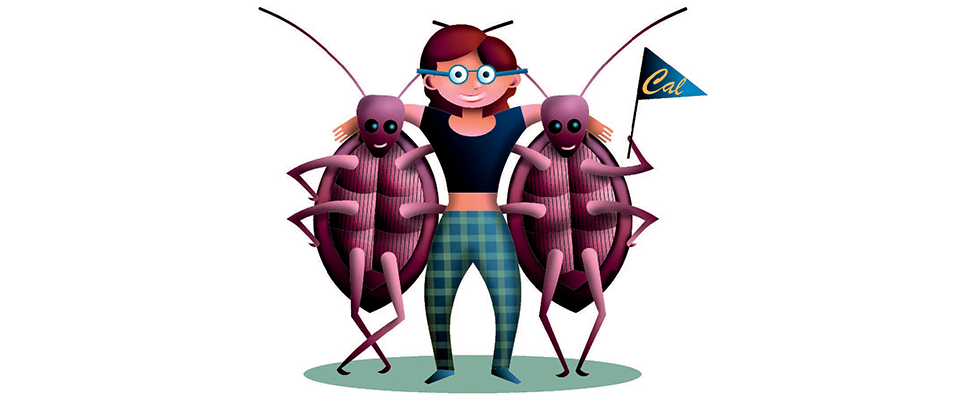I live with my boyfriend, Chris, in a rent controlled, one-bedroom apartment in San Francisco. It’s cozy, old, and definitely not big enough to fit both my extensive rock/bone/shell collection and his growing assemblage of street art—but overall, it feels clean. Or at least it did. Until about a year ago, when we found our first visitor crawling out of the kitchen sink, like a scene in some Japanese horror film.
Yes, cockroaches. Most likely the American roach, Periplaneta americana. My arrival to the apartment last year, with my excessive snacking and subsequent crumb dropping, and the birth of these creepy crawlers was no coincidence. But it was pretty ironic that the girl who’s worked at a bug museum for four years brought the infamous pests to an apartment that’s been roach free for nearly a decade. Chris, though, wasn’t laughing.
House cockroaches and other insects may seem icky, but by pushing aside the repulsion instinct, you make room for wonderment. I will concede, there is a time and place for insect marveling.
It all reminded me that most people outside my entomology museum bubble do not have warm feelings towards insects. When Chris sees the roaches, he sees disease, filth, and contamination. When I see them, sure, I get a bit creeped out. But I also see beautiful organisms that can run up to 50 body lengths per second, the equivalent of a human moving at hundreds of miles per hour. Some species of cockroach take care of their young for extended periods of time. Ecologically speaking, they mostly eat rotten organic matter and thus are an important part of the decay chain. Then there’s the German cockroach, Blattella germanica, another common pest that can produce a colony of 300,000 from a single female sneaking into your house. Terrifying? Sure. Impressive? Without a doubt.
Or take the termite, a close relative of the cockroach; basically a roach that eats wood. One of my favorite termite species lives underground in South Africa but builds huge, 15–20 foot towers above ground in order to ventilate a house with over 2 million occupants. The human equivalent would be four times taller than a New York skyscraper that is five square miles at the base.
Inside the tower an intricate network of passages leads to a central chimney. Hot, stale air rises up, but the top of the structure is sealed, forcing fresh air through tiny holes in the walls and into the tunnels that expand in diameter. The fresh air is blown around, creating a current that pulls more stale air out of the structure. And they do all this without an architecture or engineering degree.
Below the chimney are tunnels filled with garden chambers where fungus is cultivated that rots wood to make it digestible. Deeper in the mound is a queen so huge and swollen that workers have to clean and feed her. Her partner, with whom she founded the colony maybe 20 years ago, is still with her, and stays with her throughout life. She can pop out 30,000 eggs a day and when they hatch, workers feed them with compost from their fungus gardens.
I can “bug” people with stories like these for days. Stories of bees that carry out Shakespearean dramas in their all-female colonies. Or dragonfly-like critters that will wrap themselves in pearls and jewels if placed among them. I see insects as unlimited story mines that constantly remind me of the nuanced, beautiful, and tough mastermind called evolution, and how far it has gone to allow creatures to thrive in crazier situations than a human mind can even imagine.
Insects were the first animals to venture outside the safety of the sea to colonize the harsh land. They were the ones who established the fundamental terrestrial ecosystems. As insects diversified, so did plants, leading to radiations of all life. The insects transcend limitations of size by becoming perfect, diverse survival machines. If humans were to disappear from Earth tomorrow, everything would be fine, probably better. But if the creepy crawlers of the undergrowth disappeared, life on Earth would collapse. Soil would lose fertility, many plants would not be pollinated, larger vertebrates would lose their food supply, and the energy web arising from it would suffer and collapse. Essentially, Earth would become a barren pasture covered in waste and decay.
House cockroaches and other insects may seem icky, but by pushing aside the repulsion instinct, you make room for wonderment. I will concede, there is a time and place for insect marveling. I respect my boyfriend’s need for a pest-free apartment, and so roach D-Day looms. Even though their fate will be a stinky haze of bug bomb, we’d do well to remember—they’re part of something so much greater than their bad reputation.



















